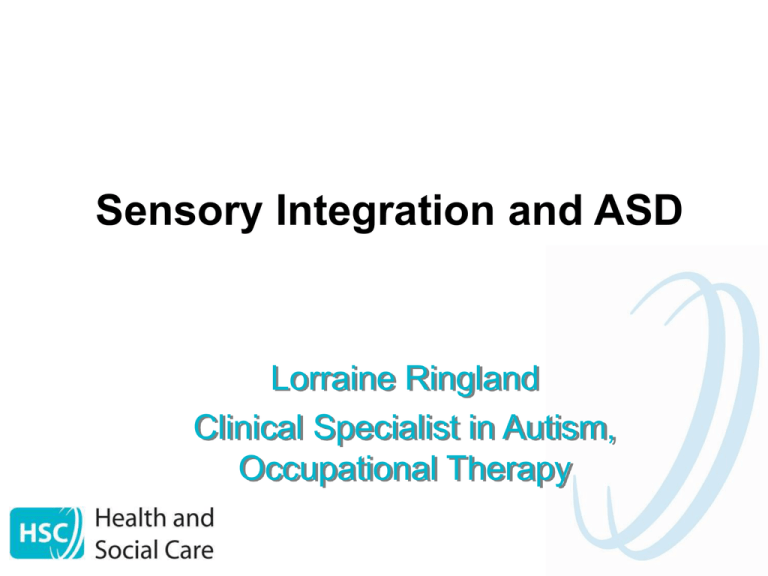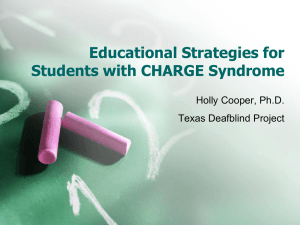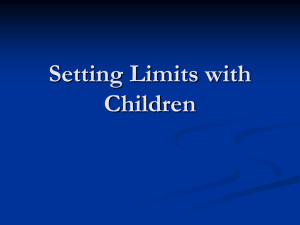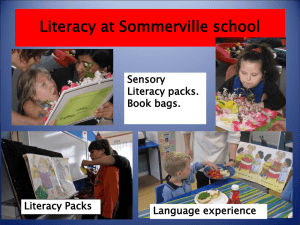Sensory Issues and ASD - Living and Learning Together
advertisement

Sensory Integration and ASD Lorraine Ringland Clinical Specialist in Autism, Occupational Therapy This Talk Aims to Explain What is Sensory Integration? What is Sensory Integration Difficulties? What have they to do with Autism? How do Sensory Integration Difficulties present and what parents can do? The Concept of Sensory Integration Sensory Integration is the ability to take in, sort out, process and make use of information from the world around us. Ineffective Sensory Processing Can effect one or more of sensory systems. Impacts upon ability to: – Learning – Cope with daily demands and stress – Direct behaviour effectively A comparison can be drawn to indigestion… Sensory Processing Disorder and Autism Literature indicates that 42% to 88% of children diagnosed with Autism will also experience sensory processing difficulties. – These children often have difficulty regulating responses to sensations and specific stimuli and may use selfstimulation to compensate for limited sensory input or to avoid overstimulation. – (Baranek, 2002). (Roberts, King-Thomas, & Boccia, 2007; Schaaf & Nightlinger, 2007; Smith, Press, Koenig, & Kinnealey, 2005). Behaviours such as stereotypic motor movements, aimless running, aggression, and self-injurious behaviours have been correlated with these sensory processing difficulties. – (Case-Smith & Bryan, 1999; Dawson & Watling, 2000; Linderman & Stewart, 1999; Watling & Dietz, 2007). • 7 Sensory Systems • How Difficulties Present • Tips for Parents 7 Sensory Systems Body Position (Proprioception) Movement (Vestibular) Touch (Tactile) Sight (Visual) Taste (Gustatory) Sound (Auditory) Smell (Olfactory) PROPRIOCEPTION (Body awareness) Location: receptors located in muscles and joints and is activated by muscle contraction Function: provides information about where a body part is and how it is moving. Has a calming effect on the sensory system. Proprioception – exhibiting behaviours Heavy handed or footed Poor judgement and grading of movement Poor posture, frequently props head on hands/table Bumps into things, falls frequently Tip toe walking Drops things frequently Tires easily Poor body awareness May chew on non-food objects or grinds teeth Proprioceptive Strategies Tug of war games Heavy loads: encourage child to carry the shopping bags Wheelbarrow walking Arm/foot wrestling Trampolining Climbing frames Monkey bars Please Note, when a child is overwhelmed / overactive, engaging them in activities which activate the Proprioceptive sense should help them to become more calm. Over Sensitive – Low Thresholds Under Sensitive - High Thresholds VESTIBULAR (Movement and balance) Location: receptors in the inner ear, stimulated by head movements and input from other senses Function: Provides information about where our body is in space, whether we are moving standing still and what speed and direction we are going Vestibular – exhibiting behaviours Overly Sensitive Poor tolerance to movement Easily become dizzy when changing body position Dislike tipping their head back Overly fearful of heights May experience motion sickness May move quite rigidly Under Registering Seeks fast moving activities Spins, rocks, bounces and jumps excessively Always ‘on the go’ Enjoys being upside down Slouches and leans, unable to sit upright for long Tips for Parents - Vestibular Extra proprioception or pressure helps a child feel more secure. Encourage active child propelled movements rather than passive movement. Fast movements with changes in direction are alerting, slow rhythmical movements tend to be calming and soothing Try having your child complete some activities in different positions, e.g. lying on stomach to read. Take small steps towards more challenging activities, break them down so that movement is minimalised. TACTILE (Touch) Location: receptors under the skin Function: Provide information to the brain regarding the environment or object (touch, pressure, texture, hard, soft, sharp, dull, heat, cold and pain) Tactile – exhibiting behaviours Overly Sensitive Fussy Sensitive to textures Dislikes and avoids likes messy play Can react aggressively to another’s touch Feels pain excessively Very sensitive to temperature changes. Distressed at grooming activities, e.g. brushing hair/teeth, cutting nails Under Registering Responds only to firm touch Can invade space / be overly tactile Can be heavy handed Grips objects too firmly Has difficulty responding to pain/temperature. May be unaware of food left in his mouth Frequently seeks the feel of objects in his/her environment Tips for Parents - Tactile If your child is seeking out tactile experiences, feed them. If the child avoids tactile experiences, incorporate proprioceptive tasks and consider the texture of toys, clothes, towels, etc. Light touch can be irritating, firm and constant pressure organising Remember self-initiated touch produces a less defensive reaction to the sensory system. Avoid situations of close proximity to others Always watch for signs of overstimulation and discomfort, remember that tactile experiences can be painful for some children. AUDITORY (Sound) Location: inner ear stimulated by sound/air waves Function: Provides information about sounds in the environment (loud, soft, high, low, near or far) Hearing – exhibiting behaviours Overly Sensitive Reacts as though noise levels are magnified Dislikes loud noise Is easily startled Engages in unusual behaviours in noisy environments Is anxious before expected noises (school bell) Holds hands over ears Highly aware of all environmental noises Under Registering Enjoys really loud noise Fails to pick up expected cues. Makes unusual noises themselves Seek out irritable noises, e.g. white noise May become more engaged in noisier environments Tips for Parents Prepare the child for noisy environments. Use headphones or ear defenders to ‘dampen down’ the level of noise for the child. Teach your child strategies within noisy environments, e.g. standing close to the door. Agree methods for your child to tell you there is too much noise, e.g. token exchange, loud gauges or happy/sad faces. Encourage the child to attend to sounds by playing games based on auditory cues, e.g. Simon Says. VISUAL (Sight) Location: retina in the eye which is stimulated by light Function: provides information about what we see in the environment and helps us define boundaries as move in space Visual – exhibiting behaviours Difficulty finding what they are looking for unless the item is strongly motivating Difficulty concentrating in a very bright, visually stimulating room May become overly focused on visual detail Advanced drawing skills String visual memory Tips for Parents Reduce lighting, particularly when the child appears overwhelmed Reduce the amount of visual distractions Be aware of visual challenges, e.g. copying from a board, reading text Present work in visual blocks Remember it may be difficult for the child to look at you and listen to you simultaneously OLFACTORY and GUSTATORY (Smell) Location: chemical receptors in the nose (closely linked to the taste sense) Function: Provides information about different types of smell (musty, acrid, putrid, flowery and pungent) (Taste) Location: Chemical receptors in the tongue (closely linked with the smell sense) Function: Provides information about different types of taste (sweet, sour, bitter, salty, spicy) Taste and Smell – presenting behaviours Overly Sensitive Dislikes strong tastes prefers bland Tastes or smells objects, clothes etc Likes consistent temperature of food Over-reacts to common smells Gags easily at subtle smells Under Registers Mouths and or smells nonfood items Craves strong tastes and flavours Under-reacts to strong smell, may seek them. Tips for Parents Incorporate foods into messy play Introduce tastes in a fun way and expand on established tastes Use calming scents or scents the child prefers, in small amounts e.g. lavender etc Use scented stickers to assist in desensitising Allow the child to chew gum/suck hard sweet In environments with distinctive smells, e.g. canteen or dentist, have the child’s favoured scent on cotton wool / sleeve to help calm Use calming activities when the child is overwhelmed, i.e. proprioceptive activities IMPORTANT POINTS When a child displays unacceptable behaviour consider an underlying sensory processing cause. Acknowledge the difficulties children with sensory processing experience across contexts and how this affects their life skill development and academic readiness Accentuate the positive and always offer understanding and support Thank you for your Attention Any Questions?










